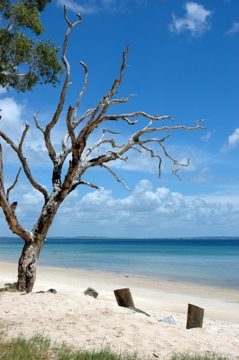Fraser Island is a long and narrow island, 120 km by up to 24 km wide, situated on the east coast of Australia. It has the honour of being the largest sand island in the world and the largest island on the Australian east coast. It was even visited by James Cook. The island owes its name from Eliza Fraser, a shipwreck survivor.
The largest sand Island
The sand from Fraser Island originates from neighbouring Australia and was carried across the sea by strong currents. A volcanic bedrock lying below the island provided a natural catchment area for the sand to collect. However, the same current responsible for the accumulation of sand is also causing the erosion of beaches, which will only accelerate as the sea level rises. The hills on the island are made up of sand; due to the combination of wind and sand, sand dunes shift 1 – 2 m every year.
Fraser Island is a favourite among tourists who come for its stunning natural beauty, whether it be beaches, forests or lakes. The island is a World Heritage site and the Great Sandy National Park which covers most of the island and is administered by the Environmental Protection Agency, also serves to protect its wildlife habitat.
Beautiful scenery
The island boasts over 100 fresh water lakes, the second highest concentration in Australia after Tasmania and they are exceptionally clean. In fact, it is said that sunscreen and urine from campers are the major polluters of the lakes, many of which do not have any inflow or outflow of water. In a bid to keep pollution to a minimum, vessels with motor engines are not allowed on the lakes; this includes jet skis and motor boats.
Among the rich flora, one can find rainforests growing in sand, eucalyptus trees, mangroves and swamps. Wallabies, possums, bats, sugar gliders, large variety of bird species and rare species of butterflies, saltwater crocodiles are all among the rich variety of wildlife that live and thrive in the multiple natural habitats on Fraser Island.
Dingoes on Fraser Island
Fraser Island is particularly known for its dingoes that are claimed to be the purest across all of Australia. Dogs are not allowed on the island to prevent cross-breeding and the introduction of diseases which could reduce the population of the dingoes, now a protected species on the island.
Despite numerous rules to protect the island from negative human influence, there is a permanent human population settled there, circulating around 360 people.
For more popular travel destinations, why not have a look at Travel Blat or go to Australia’s mainland – Brisbane – for a date ?
